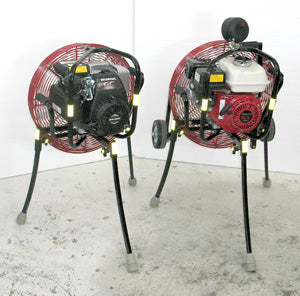Honda GX versus GC Engines
Effective the end of 2021, Honda discontinued production of certain general-purpose engines, including the GC160, in order to focus their production on new models. Due to this, Ventry Solutions, Inc. has discontinued Ventry Fan Models 20GC160 and 24GC160.
What is the difference between the Honda GX and GC series engines?

Ventry® Ventilation Fans, patented portable gas and electric fans used primarily in fire fighting and brush burning / slash pile burning, now utilize Honda GX-series engines (effective January 2022). Prior to 2022, Ventry Fans also utilized Honda's GC160 motor, but discontinued those models when Honda stopped production of the GC-series engines. Since many of the GC-series motors are still in use, below is a comprehensive overview of the main differences between Honda's GX- and GC-series motors.

Honda GX engine |

Honda GC engine |
| GX-Series | GC-Series | |
| Suggested Type of Use | Commercial | Residential [1] |
| Low-Oil Shut-Off (prevents damage to the engine) | Yes | No |
| Engine Material | Mostly metal | Mostly plastic |
| Bore Material | Cast iron (giving GX-series motors longer life) | Aluminum |
| Fuel-Shutoff Valve [2] | Yes | No |
| On/Off Switch [3] | Yes | Yes, combined into the throttle control |
| Place of Origin | Thailand (subject to change) | USA |
| Warranty (commercial use) | 3 years | 3 months |
A bonus of the GX-series engines when used with Ventry Fans, is that models 20GX160 and 24GX160 (each consisting of a GX160 motor) are available with an integral power supply unit used to run a halogen or LED Point of Entry (POE) Safety Light. Since the POE Safety Light is wired directly to an alternator in the engine, it was not available on the economy GC160 or as an add-on to existing Ventry Fans.
NOTES
[1] GC-series engines can be used in commercial equipment, but the warranty period will be shortened.
[2] A major benefit of the fuel-shutoff valve is that if the motor is run infrequently, the fuel can be run out, which is easier on the carburetor. Also, shutting off the fuel valve prevents the accidental mixing of oil and fuel, which can happen if the motor is jostled a lot (for example, when a fan is carried on a truck over a bumpy road).
[3] Having the on/off switch combined in to the throttle control (as with the GC motors) makes for simpler operation, but it has the drawback of not being able to run the fuel out of the carburetor.
Share this post
Latest News & Articles
Brush Burning Fans
Several of the unique qualities which make Ventry Fans ideal for fire fighting also make them a great investment for brush/slash burning. Contractors often want 4 or more brush burner fans for huge land clearing projects; they soon realize only one Ventry Fan is needed!

Photos compare lighting options for Linemen
Photos by local linemen: They tested safety lighting solutions during overhead pole work and trench work. Photos compare headlights, spotlight, and Lentry® Portable Lighting.

Lentry Lights make quick work of nighttime repairs
See how Lentry Light Systems with a single LED light head help utility companies see and be safer when having to work at night.

Stay in touch
CALL US
We’d love to hear from you and will be happy to answer your questions and assist you with our products. Call (888) 257-8967.
E-NEWSLETTER
Sign up here for our once-a-month email of GREAT NEWS!
